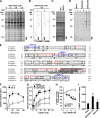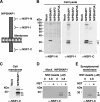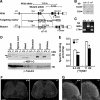Identification of NIPSNAP1 as a nocistatin-interacting protein involving pain transmission
- PMID: 22311985
- PMCID: PMC3322983
- DOI: 10.1074/jbc.M111.271866
Identification of NIPSNAP1 as a nocistatin-interacting protein involving pain transmission
Abstract
4-Nitrophenylphosphatase domain and non-neuronal SNAP25-like protein homolog 1 (NIPSNAP1) is a molecule of physiologically unknown function, although it is predominantly expressed in the brain, spinal cord, liver, and kidney. We identified NIPSNAP1 as a protein that interacts with the neuropeptide nocistatin (NST) from synaptosomal membranes of mouse spinal cord using high-performance affinity latex beads. NST, which is produced from the same precursor protein as an opioid-like neuropeptide nociceptin/orphanin FQ (N/OFQ), has opposite effects on pain transmission evoked by N/OFQ. The calculated full-length pre-protein of NIPSNAP1 was 33 kDa, whereas the N-terminal truncated form of NIPSNAP1 (29 kDa) was ubiquitously expressed in the neuronal tissues, especially in synaptic membrane and mitochondria of brain. The 29-kDa NIPSNAP1 was distributed on the cell surface, and NST interacted with the 29-kDa but not the 33-kDa NIPSNAP1. Although intrathecal injection of N/OFQ induced tactile allodynia in both wild-type and NIPSNAP1-deficient mice, the inhibition of N/OFQ-evoked tactile allodynia by NST seen in wild-type mice was completely lacking in the deficient mice. These results suggest that NIPSNAP1 is an interacting molecule of NST and plays a crucial role in pain transmission.
Figures






Similar articles
-
Pain regulation by nocistatin-targeting molecules: G protein-coupled-receptor and nocistatin-interacting protein.Vitam Horm. 2015;97:147-65. doi: 10.1016/bs.vh.2014.12.001. Epub 2015 Jan 14. Vitam Horm. 2015. PMID: 25677771 Review.
-
Modulation of synaptic transmission by nociceptin/orphanin FQ and nocistatin in the spinal cord dorsal horn of mutant mice lacking the nociceptin/orphanin FQ receptor.Mol Pharmacol. 2001 Mar;59(3):612-8. doi: 10.1124/mol.59.3.612. Mol Pharmacol. 2001. PMID: 11179457
-
Nocistatin: a novel neuropeptide encoded by the gene for the nociceptin/orphanin FQ precursor.Peptides. 2000 Jul;21(7):1101-9. doi: 10.1016/s0196-9781(00)00247-3. Peptides. 2000. PMID: 10998544 Review.
-
Involvement of NIPSNAP1, a neuropeptide nocistatin-interacting protein, in inflammatory pain.Mol Pain. 2016 Mar 10;12:1744806916637699. doi: 10.1177/1744806916637699. Print 2016. Mol Pain. 2016. PMID: 27030720 Free PMC article.
-
Selective suppression of inhibitory synaptic transmission by nocistatin in the rat spinal cord dorsal horn.J Neurosci. 2000 Jul 1;20(13):4922-9. doi: 10.1523/JNEUROSCI.20-13-04922.2000. J Neurosci. 2000. PMID: 10864950 Free PMC article.
Cited by
-
Nipsnap1-A regulatory factor required for long-term maintenance of non-shivering thermogenesis.Mol Metab. 2023 Sep;75:101770. doi: 10.1016/j.molmet.2023.101770. Epub 2023 Jul 7. Mol Metab. 2023. PMID: 37423391 Free PMC article.
-
Functional plasticity of the N/OFQ-NOP receptor system determines analgesic properties of NOP receptor agonists.Br J Pharmacol. 2014 Aug;171(16):3777-800. doi: 10.1111/bph.12744. Br J Pharmacol. 2014. PMID: 24762001 Free PMC article. Review.
-
NIPSNAP protein family emerges as a sensor of mitochondrial health.Bioessays. 2021 Jun;43(6):e2100014. doi: 10.1002/bies.202100014. Epub 2021 Apr 14. Bioessays. 2021. PMID: 33852167 Free PMC article. Review.
-
Endogenous Neuropeptide Nocistatin Is a Direct Agonist of Acid-Sensing Ion Channels (ASIC1, ASIC2 and ASIC3).Biomolecules. 2019 Aug 22;9(9):401. doi: 10.3390/biom9090401. Biomolecules. 2019. PMID: 31443477 Free PMC article.
-
Genetic and pharmacological evidence that endogenous nociceptin/orphanin FQ contributes to dopamine cell loss in Parkinson's disease.Neurobiol Dis. 2016 May;89:55-64. doi: 10.1016/j.nbd.2016.01.016. Epub 2016 Jan 22. Neurobiol Dis. 2016. PMID: 26804029 Free PMC article.
References
-
- Seroussi E., Pan H. Q., Kedra D., Roe B. A., Dumanski J. P. (1998) Characterization of the human NIPSNAP1 gene from 22q12. A member of a novel gene family. Gene. 212, 13–20 - PubMed
-
- Satoh K., Takeuchi M., Oda Y., Deguchi-Tawarada M., Sakamoto Y., Matsubara K., Nagasu T., Takai Y. (2002) Identification of activity-regulated proteins in the postsynaptic density fraction. Genes Cells 7, 187–197 - PubMed
-
- Surendran S., Tyring S. K., Matalon R. (2005) Expression of calpastatin, minopontin, NIPSNAP1, rabaptin-5 and neuronatin in the phenylketonuria (PKU) mouse brain. Possible role on cognitive defect seen in PKU. Neurochem. Int. 46, 595–599 - PubMed
-
- Tummala H., Li X., Homayouni R. (2010) Interaction of a novel mitochondrial protein, 4-nitrophenylphosphatase domain and non-neuronal SNAP25-like protein homolog 1 (NIPSNAP1), with the amyloid precursor protein family. Eur. J. Neurosci. 31, 1926–1934 - PubMed
-
- Nautiyal M., Sweatt A. J., MacKenzie J. A., Mark Payne R., Szucs S., Matalon R., Wallin R., Hutson S. M. (2010) Neuronal localization of the mitochondrial protein NIPSNAP1 in rat nervous system. Eur. J. Neurosci. 32, 560–569 - PubMed
Publication types
MeSH terms
Substances
LinkOut - more resources
Full Text Sources
Medical
Molecular Biology Databases

